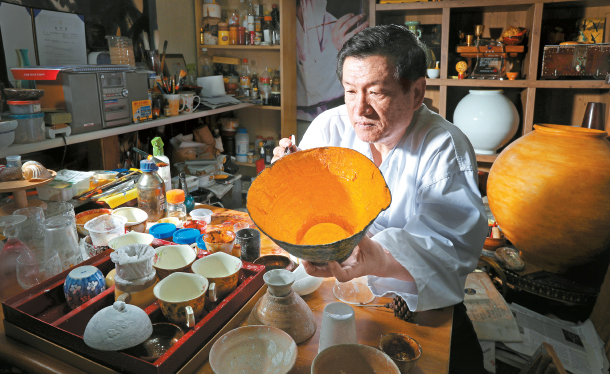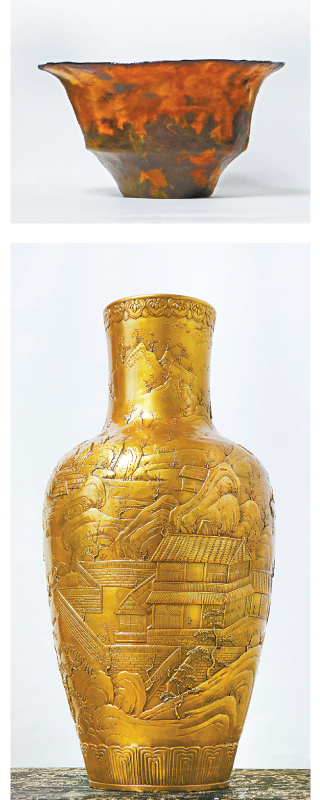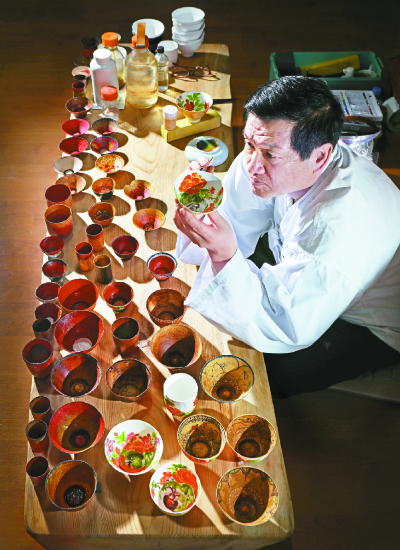[ZOOM KOREA] Reviving Korea’s forgotten gold standard

Master craftsman Koo Young-kuk works on his hwangchil, or golden lacquer, handcrafts at his studio located in the Bundang area of Seongnam, Gyeonggi. [PARK SANG-MOON]
Hwang means yellowish gold, while chil means to paint in Korean.
Since the technique originated in the ancient Baekje period (18 B.C. - A.D. 660), it is also dubbed “Baekjechil.”
Despite its beauty, the tradition has been forgotten since the late 18th century. But recently, the lost tradition has been revived by master craftsman Koo Young-kuk, who was designated a master of golden lacquer in 2014 by the United Nations World Rehabilitation Organization.
The hwangchil tree is a native species that only grows in Korea. Its scientific name is Dendropanax morbifera and the tree is found near Haenam in South Jeolla and Jeju.
The sap is only extracted from hwangchil trees that are 15 years old or older, of which only 10 percent are able to do so. In addition, the maximum amount you can get from a single tree is only 8.6 grams (0.3 ounces), making it precious and pricey.
The sap is often dubbed “ginseng you can get from a tree” and is mostly used for two purposes: for medicinal uses and for crafts.

Koo is currently working on painting tea cups, top, made with hanji (traditional Korean paper) up to 600 times with hwangchil. A porcelain jar, below, that was painted in hwangchil over 10 years by Koo. The price of the jar is estimated to be around 3 billion won ($2.5 million). [PARK SANG-MOON]
Qin Shi Huang (B.C. 259 - B.C. 210), the founder of Qin Dynasty, dreamt of immortality. He made his envoy, known as Seobok, sail across the sea and reach Jeju in search of herbs that would promise him eternal youth. The herb they found was, in fact, the hwangchil tree, according to ancient documents.
Jeong Yak-yong, a scholar from the Joseon Dynasty (1392-1910), even wrote poetry about the hwangchil tree and admired the beauty of the color the tree produced.
Hwangchil was mostly used by royal families, but the traditional technique evaporated due to diplomatic relations with China.
King Chungnyeol of Goryeo (1236-1308) sent 10 jars of sap - which would have taken 10 years to collect - along with craftsmen who can make handcrafts using the sap to the Yuan Dynasty.
The Qing Dynasty forced Joseon to send hwangchil as a tribute and exploited all the hwangchil available in the nation, too.
Peasants who toiled away all day long to harvest the sap from hwangchil trees eventually cut down the trees in the hopes of ending their work. The native trees soon became extinct.
It took a long time for craftsman Koo to learn what hwangchil was. Instead, he was fascinated by mother-of-pearl lacquerware when he first saw it as a high school student. He saw a wardrobe at his friend’s house that was inlaid with mother-of-pearl.
After graduating from a high school in 1978, Koo landed a job at a factory producing mother-of-pearl lacquerware instead of advancing to college. He cleaned up the factory and ran errands for the first year, but he eventually started to learn the traditional techniques. In 1983, he opened his own factory in the Hannam neighborhood of Yongsan District, central Seoul.
Running his own business was not easy. Two years into his business, Koo was on the brink of bankruptcy and felt mentally exhausted. He needed some fresh air, so in 1985, he left for Geumsan Temple, located in Gimje, North Jeolla.
When he was looking around the temple, somebody tapped his shoulder. It was a Buddhist monk named Cheolan who later passed down the hwangchil techniques to Koo.

Koo paints hwangchil, or golden lacquer, on tea cups made with hemp cloth. [PARK SANG-MOON]
Inside the bottle, there was hwangchil. The monk continued, “You have to make a promise with me. This one will be your life-long hwadu.”
Hwadu is a term used in Buddhism and roughly translates to a topic you keep in your mind to reach the moment of awakening.
Koo didn’t know what hwadu or hwangchil were at the time, but he would soon learn quickly.
Koo began to shuttle back and forth between Seoul and Geumsan Temple in order to learn the techniques of hwangchil.
Buddhist monk Cheolan kept stressing two things - one, to never give up, and two, to not produce products until he, Koo, becomes skilled enough. It was his last words before the Buddhist monk passed away.
After being indulged in hwangchil for two decades, Koo unveiled his own crafts in September 2005.
There were some moments when he seriously considered giving up for financial reasons, but Koo vowed that he would continue working with hwangchil until his final days.
Keeping his promise to the Buddhist monk was important for Koo, but he also valued continuing the tradition.
Koo began performing jesa, or ancestral rituals, for the deceased craftsmen five or six years ago on the very first day of the new year. By doing so, he pays tribute to his predecessors who carried on the crafting legacy over decades.
Koo is currently working on two meaningful works. One is dabbing hwangchil on tea cups made with hemp cloth. The project started in 2019, and the craftsman expects that it will take 10 years to complete. The tea cups will be put on display in Japan as an invitational exhibition. He hopes to show the excellence of hwangchil to Japan through the exhibition.
Another project of Koo is expected to take 30 years to complete. Koo aims to paint tea cups made with hanji, traditional Korean paper, 600 times. So far, he has painted them 80 times.
Koo’s hwangchil crafts have been delivered as gifts to the former presidents of Brazil, Austria, Romania and Sri Lanka.
By producing hwangchil crafts, Koo is serving as a cultural ambassador who promotes the excellence of hwangchil all around the world.
BY PARK SANG-MOON [moonpark@joongang.co.kr]










with the Korea JoongAng Daily
To write comments, please log in to one of the accounts.
Standards Board Policy (0/250자)